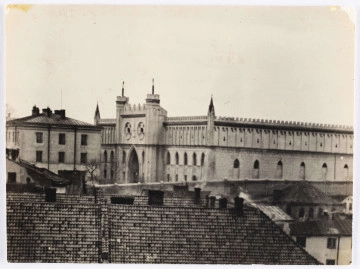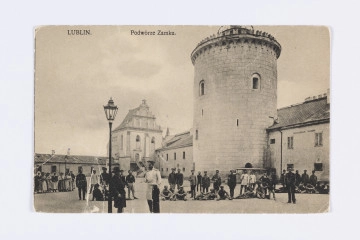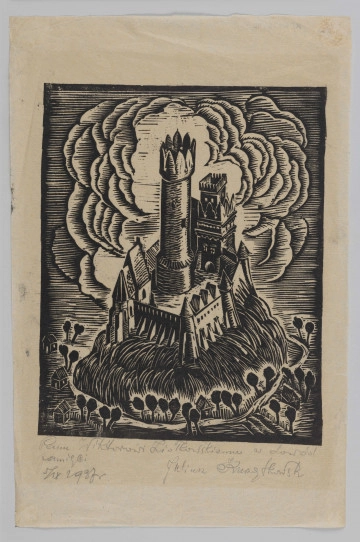
Prison at the Castle in Lublin
National Museum in Lublin
Part of the collection: Lubliniana. Painting views of Lublin and the Lublin Region
Napoleon Orda went down in Polish culture as the author of an artistic inventory of national monuments, which is still a valuable iconographic source.
As a student, he belonged to secret patriotic organisations. After the fall of the November Rising (for his participation in it, he received the Virtuti Militari Gold Cross), he had to go abroad. In Paris, he participated in the life of the Great Emigration and developed his talents - he took music lessons from Chopin and Lista, and studied drawing. On his return, he was a tutor at the home of General Adam Rzewuski in Wierzchownia in the Ukraine. This is where his passion for drawing the Polish borderlands developed. In 1872, Orda began creating a visual documentation of Poland. In order to immortalise the world passing into the past, he travelled across the country every year. He visited Volhynia, Podolia, Ukraine, Lithuania, Samogitia, Belarus, Livonia, Galicia, Poznan, Royal Prussia and the Kingdom of Poland. He made over a thousand drawings and watercolours. He worked out his own style, reflecting the character of the native landscape. Between 1773 and 1783, he published eight volumes of views of Poland with two hundred and sixty lithographs. The drawings were transferred onto lithographic stone by Alojzy Misierowicz, the prints were made in the workshop of Maksymilian Fajans. On the first page, the artist included a landscape from Worocewicz, where he was born, and the title of the publication: Album Widoków Historycznych Polski poświęcony Rodakom zrysowany z natury przez Napoleona Ordę / Przedstawiający miejsca historyczne od początku Chrześcijaństwa w Polsce, Ruiny Zamków Obronnych z czasów Tureckich, Tatarskich, Krzyżackich, Kozackich i Szwedzkich, Piękne Rezydencje / Świadczące o przeszłości i cywilizacji w tym Kraju oraz miejsca urodzenia ludzi wsławionych piórem lub nauką. [The Album of Historical Views of Poland Dedicated to the Compatriots Drawn from Nature by Napoleon Orda / Presenting Historic Places from the Beginning of Christianity in Poland, Ruins of Defensive Castles from the Times of the Turks, Tatars, Teutonic Knights, Cossacks and Swedes, Beautiful Residences / Testifying to the Past and Civilisation in this Country, and Birthplaces of People Famous in Literature and Science].
Widok dziedzińca zamku w Lublinie z basztą i kaplicą [The View of the Courtyard of the Lublin Castle with a Tower and a Chapel] comes from the last portfolio. The picture shows a fragment of the buildings of the Lublin castle, already then turned into a prison. In the foreground there is a donjon, in the background there is a block of the late Gothic Chapel of the Holy Trinity. By its northern wall stands the former mansions' house, next to it a slender chapel. The space in front, with the small figure, is drowned in deep shadow, the courtyard with the white facade of the chapel is illuminated by the sun. Misierowicz, copying the drawing, used a fine, delicate line, thanks to which he achieved a precise and rich in detail, and at the same time subtle modelling of solids.
Bożena Kasperowicz
Author / creator
Dimensions
cały obiekt: height: 19,9 cm, width: 28,4 cm
Object type
graphics
Technique
toned lithography
Material
paper
Creation time / dating
Creation / finding place
Owner
The National Museum in Lublin
Identification number
Location / status

unknown
National Museum in Lublin

Ślusarski
1907 — 1911
National Museum in Lublin

Kurzątkowski, Juliusz
National Museum in Lublin
DISCOVER this TOPIC
Museum of King Jan III's Palace at Wilanów
DISCOVER this PATH
Educational path
0/500

We use cookies to make it easier for you to use our website and for statistical purposes. You can manage cookies by changing the settings of your web browser. More information in the Privacy Policy.
We use cookies to make it easier for you to use our website and for statistical purposes. You can manage cookies by changing the settings of your web browser. More information in the Privacy Policy.
Manage cookies:
This type of cookies is necessary for the website to function. You can change your browser settings to block them, but then the website will not work properly.
WYMAGANE
They are used to measure user engagement and generate statistics about the website to better understand how it is used. If you block this type of cookies, we will not be able to collect information about the use of the website and we will not be able to monitor its performance.